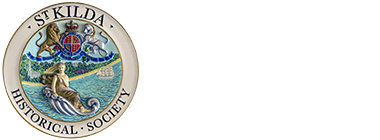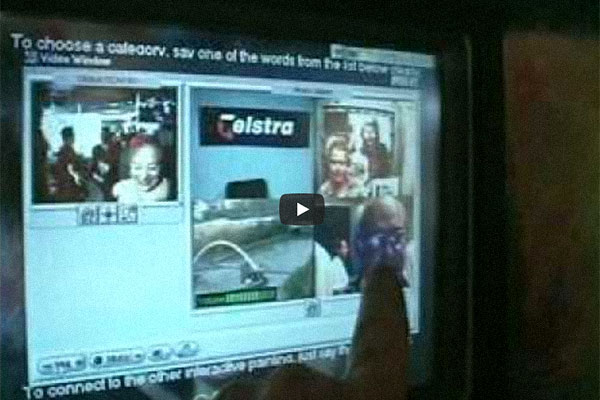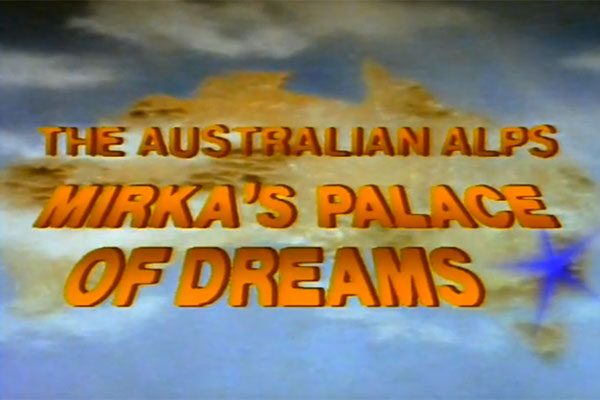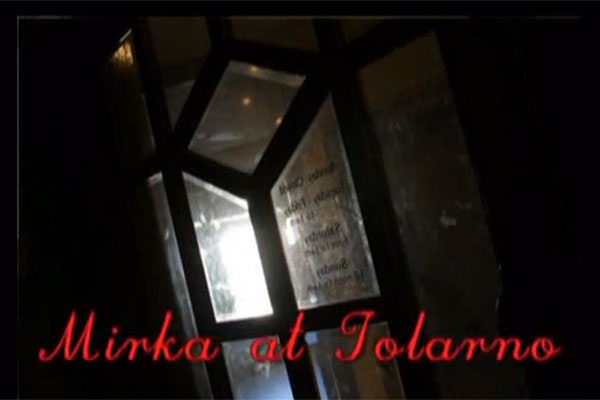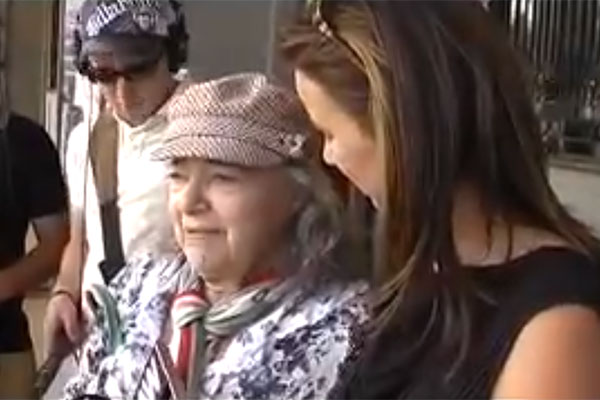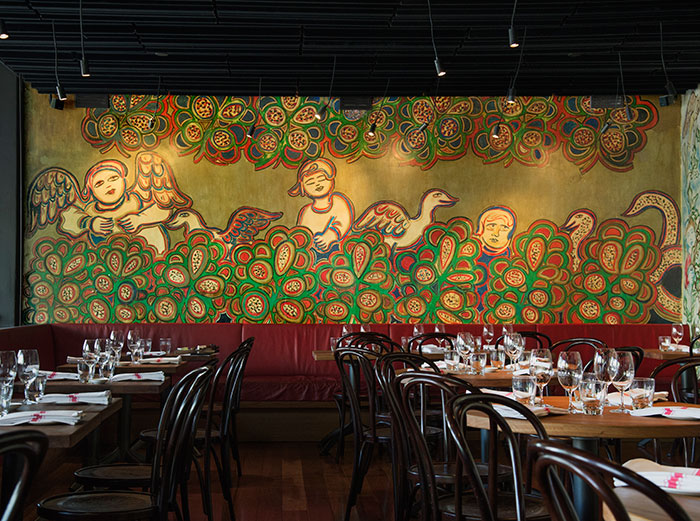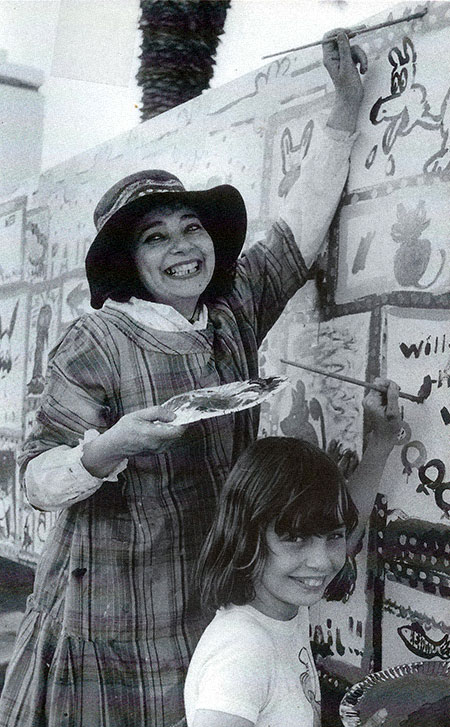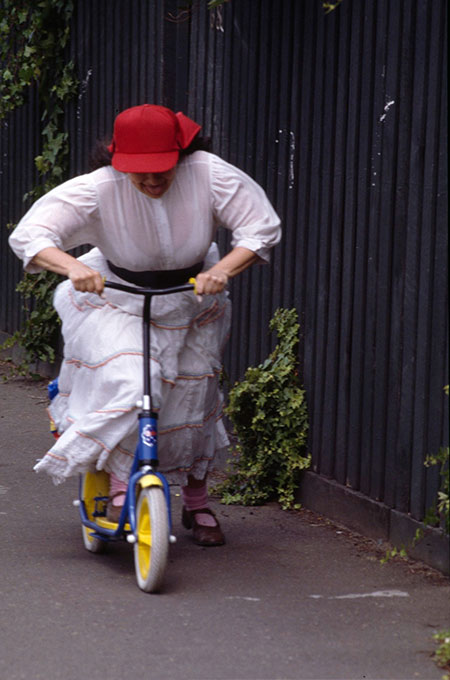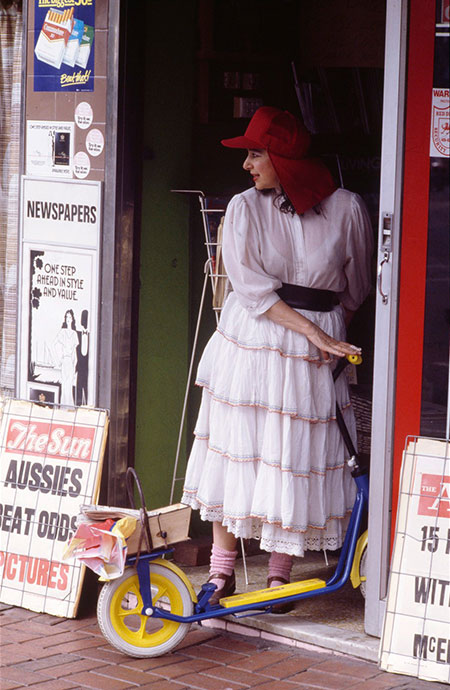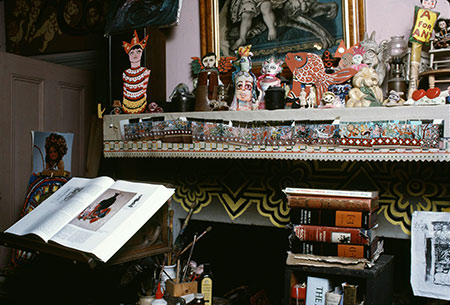Late in 1981, Mirka bought 116 Barkly St, a one storey, single-fronted Victorian terrace built c.1890. She wrote to me: ‘I am in the midst of moving studio so you might know what it means in my case. I wonder if I will move once more before I die...Well back to packing and selling works to get money for [a drawing of a house]. Mirka was delighted to return to St Kilda. She was also thrilled to have the security of her own home which Georges helped her to buy. (St Kilda was, at that time, very affordable.) She’d endured the unpredictability of rental accommodation since leaving the Tolarno.
Late in 1981, Mirka bought 116 Barkly St, a one storey, single-fronted Victorian terrace built around 1890. She wrote to me ‘I am in the midst of moving studio so you might know what it means in my case. I wonder if I will move once more before I die...Well back to packing and selling works to get money for (a drawing of a house)’. (62)
Mirka was delighted to return to St Kilda. She was also thrilled to have the security of her own home which Georges helped her to buy. (St Kilda was, at that time, very affordable.) She’d endured the unpredictability of rental accommodation since leaving the Tolarno.
Moving Mirka was quite an ordeal, given her huge collection. Assisting the move fell to William. It has left him with an invaluable memory of his mother’s oeuvre – both as an artist and a collector. He recalls that ‘Mirka did the packing herself. Then I used to take ten boxes per week for nine months to Barkly Street. Then she just slowly worked through it. She started at one end of the house and finished at the front door. There was hardly any room’. (63)
Mirka was an enduring part of my work, due to her strong ties with the cultural figures I researched: Joy Hester, Albert Tucker and Sunday Reed. In 1981, I curated Hester’s retrospective at the National Gallery of Victoria and two years later published her biography. Albert Tucker had lived at 9 Collins Street on his return to Australia in 1960, after a long stint of living abroad. Once again he became part of the Heide Circle. In 2002, I published Australian Gothic: A Life of Albert Tucker. I’d also edited the letters between Joy and Sunday – Dear Sun (1995). Lastly there was The Heart Garden: Sunday Reed and Heide (2004).
Mirka regarded these women friends with love and awe – Tucker less so. Bert’s strong opinions and his sometimes belligerent manner were not convivial for Mirka, though of course she respected him as an artist. We would sit at her crowded little table at her various homes, she would make coffee and evoke memories of Joy and Sunday. Mirka was moved by Joy’s retrospective and typically generous. She wrote to me ‘Joy’s show at N.G. (National Gallery of Victoria) was so overwhelming I kept crying right through and the poor guard didn’t know what to think of me...I am excited you are writing a book on Joy’. (64)
She recalled the first time Sunday Reed rang her – ‘a little voice with an unforgettable tone – soft, persistent, rare – (which) came from far away’. (65) She once described Sunday’s voice as ‘pale blue’. Sunday’s call marked the beginning of a long and continuous friendship/patronage. At Barkly Street, Mirka showed me a book Sunday had given her Lettres complètes d’Abélard et d’Héloïse, the correspondence between the star-crossed medieval lovers. A treasured book, it had belonged to Sunday’s mother. It was also a salient reminder that, despite the apparent chaos of Mirka’s abodes, she knew where everything was.
Other ghosts were conjured. We both mourned the death of Sweeney Reed who had committed suicide in 1979 and we speculated on the circumstances which lead to that tragic event. Sweeney was Joy Hester’s son who had been adopted by the Reeds when he was a child. Both of us were close to Kiffy Rubbo, the dynamic director of Melbourne University’s George Paton Gallery, who took her life the following year. Bridie Carter, Kiffy’s daughter, recalled the wonder of visiting Mirka’s home as a child - ‘jam-packed with a million goodies’ plus an ‘old wooden rocking-horse that she let me play on’. (66) Years later, Bridie, now an actress, found herself living next door to Mirka in Barkly Street and the two renewed their friendship. John and Sunday died in 1981 – just days after the Hester retrospective finished at the NGV. So those were times of sadness and contemplation with much to discuss and share.
Mirka was a generous friend – one evening she took me to dinner at Florentino’s after a long interviewing session. It should have been me treating her! But that was her calibre. Once I recall bemoaning the fact that I was losing my (rather slight) grasp of the French language. Immediately Mirka suggested we conduct regular French conversation, something which, due to our busy schedules, didn’t eventuate. She was present, she was focused, and there was no topic that was off limits. I recall discussing Sunday’s love affairs, both of us wondering why she had strayed. ‘I saw John’s dickie one day’, Mirka said thoughtfully, ‘and it looked very nice’.
St Kilda had always attracted a wide range of characters. Its lively and sometimes sordid street life, its mix of artists, writers and other bohemians and misfits, members of the Jewish and Eastern European communities, plus the cafes and restaurants, made it refreshingly diverse. When I moved back to Melbourne in 1984 after living in Paris, I decided to live in the suburb that most reminded me of Paris. It was St Kilda. In the 1980s, it also became well known as a backpackers’ destination. Large older homes, once boarding houses, became cheap hostels for young global travellers, giving the suburb a new lease of activity and financial growth.
Mirka ‘fell in love with (the house in Barkly Street) as it had a wooden stove’ which she ‘used twice in twenty years’. The little pantry that she ‘dreamt to stock with food was soon stocked with books and photo albums, chess boards, suitcases’. (67) Her bedroom was the end room where she could ‘see trees and birds early in the morning, and kitty loves coming through the window’. Sometimes she painted in the petit jardin, reflecting ‘painting outside changes your style, but nice sometimes to obey nature’. (68) A large nectarine tree grew in the garden which ‘made my neighbours and the birds very happy’. There was also an avocado tree which ‘makes the possums happy’ while a jasmine plant ‘grew all over and perfumed the thoughts floating about’. Mirka considered that ‘a garden has its own secrets’. (69)
Mirka didn’t have a green thumb. She was too absorbed by her artwork to spend time gardening. I often wondered whether the chaos of weeds that occupied the small plot between the front fence and the verandah was to deter criminals from robbing what looked like a derelict property, or laziness on her part. Perhaps a little of both. Barkly Street was quite a rough neighbourhood. I’m not sure if Mirka felt concerned, as she grew older, for her safety. No doubt William did, and it was why he encouraged her to move in with him.
Mirka was well-known in St Kilda from her earlier stay during the Tolarno years. Her good cheer and compelling appearance meant she soon became a local character – in which she revelled. She often went walking with a pram containing a doll or went whizzing along on a child’s scooter.
Mirka ‘occupied’ the streets of St Kilda in a way she hadn’t done in her other home/suburbs. Perhaps she felt more confident there. St Kilda was a site she ‘owned’. In Paul Cox’s 1973 film Mirka, she is shown cavorting in Fitzroy Street, chatting to (slightly bemused) passersby, then dancing with a group of children. It’s street performance art, conducted with élan.
In 1985, I’d moved into Robe Street, a few blocks from Mirka, and I often saw her in the neighbourhood, mostly in the hub of Acland Street. Comedian Rachel Berger’s parents had a cake shop there. Berger recalls
‘I often saw Mirka in our shop or walking down the street. I had no idea who she was but I’d stop and watch her always making sure she didn’t see me. I found her mesmerising long before I knew what Art was or understood its impact...She had a kind of natural rhythm in the way she spoke, the way she moved, the way she dressed and especially the way she laughed. She was like a bird in a forest offering up her song. Mirka embodied the rhythm of nature, the triumph of the individual. She offered hope’. (70)
Mirka patronised local business. Helen and Jack Halliday, who ran the bookshops Cosmos (now Readings) and Metropolis in Acland Street, became good friends. Mirka was a keen buyer of art books and non-fiction primarily. She was grateful for the ‘big discount’ the Hallidays offered her. ‘I myself don’t like to wait for a book as I usually need it for my work’. (71) Helen recalls Mirka was ‘an avid reader’, giving her art ‘a universality which is disguised by her deliberate naivety in both her life and art’. (72) Mirka had a lectern at home in order to read large, heavy volumes. At one stage, she converted her small fridge to provide more book storage, ‘a practice which her sons persuaded her to abandon’. (73)
The Hallidays returned Mirka’s custom by commissioning a mural for Cosmos, a dazzlingly colourful work, populated by tranquil angels, smiling fish and playful hybrid creatures which remains in situ.
Restaurants were also frequent destinations for Mirka. She had kept up her routine of working until early afternoon, then having a long lunch which was ‘really my breakfast, lunch and dinner in one go’. (74) A tasty repast could be had at Cicciolina’s in Acland Street where she was frequently joined by artist and close friend Ann Holt. On one occasion, surveying the menu, Mirka told Holt that her doctors had advised her to cut back on fats and rich food. ‘But what am I to do?’ Mirka asked. ‘I am French’. (75) She then ordered pan-fried brains, slow-cooked ox cheek, followed by a selection of cheeses. Or the two might adjourn to the front bar at the George Hotel in Fitzroy Street, drinking red wine as Mirka discoursed about love and infidelity.
Donovan’s on St Kilda Beach was not only important for food but for writing. It was where Mirka sometimes based herself as, during the late 1990s, she worked on her autobiography, Wicked but Virtuous: My Life (2000). Like many French intellectuals, most notably Simone de Beauvoir, she chose a cafe in which to write. The first time Mirka arrived, Gail Donovan asked if she wanted a coffee. Mirka replied,‘I would rather have a Pernod’. (76) As Mirka hadn’t brought her purse, Gail offered it gratis. Mirka returned many times, transcribing her memoir and drinking a little Pernod, ‘always at the same table close to the door, looking to the beach’. (77) Though one Christmas Day, Gail and partner Kevin were shocked when Mirka arrived with Ross - and a painting, still wet – offering it in return for a table for lunch. Christmas lunches at Donovan’s are booked out a year in advance. Nonetheless, the Donovans rallied and complied. (78)
Nearby St Kilda Pier was the site of a significant commission for Mirka – a mosaic which, though damaged, remains. It was completed in 1993. During that time, Mirka contracted and successfully recovered from cancer of the womb. She recuperated at the Novotel, a comfortable hotel on the Upper Esplanade, a stay made possible by the largesse of Neilma Gantner, a member of the Myer family, and one of Mirka’s earliest and most consistent patrons.
Each afternoon, no matter how inclement the weather, I would leave my apartment, walk down Robe Street, along the Upper Esplanade and out on to the pier. The spaciousness of sky and water, after the intense concentration of writing, was exhilarating. So was the salt scent of the sea, the rush of wind, the cries of silver gulls, the fantastic shapes of clouds, and the light - pearly-grey when overcast or burnished gold in summer. There was also the passing parade of tourists, locals and odd bods. Despite the little pavilion that somewhat sheltered Mirka’s mosaic, it was open to the weather.
I often greeted Mirka working there. I knew she had been ill and, one particularly cold and gusty day, I remonstrated with her. ‘Mirka! What are you doing out here? It’s freezing. You should be home in bed’. She shook her head. ‘Ah, no, Zhaneen. I do not want to be in my bed. I want to be here’. Work, with all its privations and discomfort, was preferable to enforced rest. Mirka was then sixty-five.
The mosaic, commissioned by City of Port Phillip, was an imaginative map of the suburb. Kevin Wilson, arts officer for the council, assisted Mirka with the planning. Generously, Mirka gave Kevin the working drawing, a lovely watercolour, which, in turn, he gave to the State Library of Victoria. As Mirka recalled the mosaic was ‘a kind of map of St Kilda. It was part of the view from my house in Barkly Street, through to the sea, past Luna Park, the Palais, the Esplanade Hotel, and so on. Walking inside my work’. (79)
It was Mirka’s tribute to her beloved home, a method of honouring and representing the suburb’s ‘classic’ features, plus the historic resonance of certain buildings - always important to Mirka. She also acknowledged the more recent additions such as the Dog’s Bar, a popular bistro named for the water bowl placed at the front for pooches. Its founder, Donleavy Fitzpatrick, was not only a generous patron of Mirka’s but, like Mirka and Georges, he lifted St Kilda’s atmosphere, giving it a stylish and contemporary edge. There was also Theatreworks and Linden Art Gallery (now Linden New Art).
Looking at the mosaic is to be reminded of how fortunate we were to be living in St Kilda at that time with its burgeoning cultural diversity, of which Mirka was an integral part. If you wanted to dine out, attend the theatre, the cinema or a gallery opening, it was all within walking distance, as was the beach. In summer, it seemed as if I lived on an island, the island of St Kilda, and everything that I needed and enjoyed was available there.
But there was grumbling about the gentrification of the neighbourhood and some residents were forced out due to higher rents. Out strolling with friends after dinner, a homeless man sneered, ‘Yuppies’, as we walked by.
Mirka took her craft seriously and thoroughly studied mosaic techniques before she began. Her ‘bible’ was Otto Demus’s monumental opus The Mosaics of San Marco in Venice (1984). Sabine Cotte undertook conservation of the mosaic in 2010. ‘Mirka always talked about mosaic as a way of painting because she cut the tiles “the width of a brush”.’ (80) The tilting of the tiles effectively caught the light, making the surface scintillate at all hours of the day. Mirka emphasised this to Cotte, telling her, ‘I hate flat surfaces in mosaic, they look dead’. (81) It was crucial knowledge for Cotte because, when she began work on the mosaic, it was damaged and some areas had to be re-created. If the mosaic had been made with perfectly aligned tiles, they would not have blended harmoniously. Ever the professional, Mirka gave Cotte ‘a short lesson on the main points that identified her personal...technique’. (82)
Mirka literally walked the map each day. Taxis were too expensive and the offer by her assistant to drive her was regarded by Mirka as an imposition. So she decided ‘to buy the best pram in town (as I love prams)’ load it up with her materials, and walk from home to the site. It meant she could ‘reassess my work along the road – that is look at Luna Park again and the Esplanade Hotel’. There were other benefits as, walking along the sea, she would get ‘good painting lessons in greys’. (83)
One afternoon, as Mirka was packing up, I asked her where she would go next. She considered it for a moment. ‘I will go to Jean-Jacques [another beach front restaurant] and have a glass of champagne and some freshly shucked oysters’. It made my afternoon tea of a biscuit and a cup of Darjeeling seem rather dull.
Over the years, Mirka added to her murals and other decorations at the Tolarno Bistro. Georges was fully committed to being a gallery director and the restaurant was expertly managed by Leon Massoni. Georges had hoped that the proximity of the restaurant to the gallery would result in customers of the former becoming art buyers of the latter. Georges once told me despondently, ‘That never worked’. In 1979, Georges relocated the gallery to River Street, South Yarra. (84)
However, attending an opening and then adjourning to the Tolarno bistro for dinner was a destination enshrined in the Melbourne art world. Perhaps the menu was reasonably priced. I cannot imagine how else we artists and writers managed to afford it.
In 2007, Guy Grossi took over and refurbished the restaurant, commissioning Mirka to refresh her murals and add more. Carlo, Grossi’s young son, as well as Ann Holt assisted her. Grossi renamed the bistro ‘Mirka at Tolarno’. Grossi had known and admired Mirka for many years. He first encountered her when he was a fifteen-year-old apprentice there. Grossi recalled that ‘she always approached her art with gusto as with her life. I learned this in relation to my own craft’. (85) The magnificent mural ensemble is today on the Victorian Heritage Database and is one of the most prominent public legacies left by Mirka to Melbourne.
When Sabine Cotte was restoring the murals, she said Mirka pointed to the child in the far right of the mural, saying, ‘That is my lover!’ meaning Ross. Lansell confirms this. He describes the mural as ‘an oversized love letter’ and comments, ‘Poor old Georges having to face that every day’. (86)
Mirka was always keen to make new friends. One of the dearest was Serge Thomann. Arriving in Melbourne from France in 1983, he worked for the cosmetics company L’Oreal. Both regularly visited the Acland Street newsagent to buy the latest French newspapers. One day in 1995, they began to chat. Impulsively, Mirka invited Serge out to lunch. He recalled, ‘It was like being submerged in another world for a few hours. It was love at first sight’. (87)
Thomann always addressed Mirka as ‘vous’, the formal version of ‘you’, rather than the more intimate ‘tu’, even though Mirka discouraged the practice. For Thomann, it was a sign of respect that acknowledged Mirka’s seniority.
By that time, Thomann had been drawn into the music industry as a photographer, creating memorable portraits of Michael Hutchence and INXS, Madonna, Kylie Minogue, John Farnham and the Rolling Stones. Active in the local community, Thomann founded unChain St Kilda, a local resident activist group committed to controlling development. Most contentious was the planned Triangle Development which would occupy the land next to the Palais Theatre and turn it into a precinct that included shops, bars, restaurants and car parks. It became a bitter and divisive local battle. Fortunately, after the 2008 election, City of Phillip councillors, including two from unChain, negotiated a financial settlement with the developer to walk away from the contract.
Due to Thomann, Mirka became involved in unChain’s protest. ‘She was there when we had our first large event outside the Palais in December 2007 with (actor/director) Rachel Griffiths, Thomann recalls. ‘Mirka allowed us to use a few of her paintings to do limited edition prints to pay for our legal and election expenses. Without Mirka, we could not have done it’. (88)
Jane Touzeau, former councillor and member of unChain concurs. 'Mirka loved the St Kilda icons. And the community loved Mirka. It was so generous, and so understanding, of her to donate some of her works to support the unChain campaign. So many people were glad to have the chance of owning a limited edition print as well as supporting the campaign to prevent the Triangle development and save the Palais.' (89)
See more of the Mirka Mora Project
Credits
{slider-ex title="Author" open="false" class="icon"}
Dr Janine Burke is an author, art historian and a local resident for thirty-five years. She is Honorary Senior Fellow, University of Melbourne and committee member, St Kilda Historical Society.
{slider-ex title="Notes" class="icon"}
{slider title="From Paris to Melbourne" open="false"}
- Albert Tucker to Sunday Reed. 31 January, 1951. John and Sunday Reed Papers, State Library of Victoria.
- Albert Tucker to John and Sunday Reed. 27 August, 1950. John and Sunday Reed Papers, State Library of Victoria.
- Mirka Mora, Wicked but Virtuous: My Life, Viking, Ringwood, 2000, p.13.
- Pithiviers station is undergoing transformation as a Holocaust museum. See Melian Solly. ‘Museum to be built at Site of Nazi Occupied France’s First Concentration Camp’, December 18, 2018. https://www.smithsonianmag.com/smart-news/museum-built-site-nazi-occupied-frances-first-concentration-camp-set-open-2020-180971126/ Accessed 1 July 2019.
- Mora, Wicked but Virtuous, p.15.
- Zelda Cawthorne, ‘Treasure Trove of Mirka’, 18 June, 2014. https://www.jewishnews.net.au/treasure-trove-from-mirka/35684 Accessed 2 July 2019.
- Mora, Wicked but Virtuous, p.15.
- Mora, Wicked but Virtuous, p.20.
- Lesley Alway and Kendrah Morgan, Mirka and Georges, A Culinary Affair, The Miegunyah Press, Heide Musuem of Modern Art, 2018, p. 21.
- For a description of the history and activities of the Oeuvre de secours aux enfants see https://www.ose-france.org/wp-content/uploads/2014/12/Bochure-100-ans-OSE-anglais.pdf Accessed 4 January 2020.
- Georges’ heroic activities in OSE are described in Monsieur Mayonnaise (2016). Documentary film. Philippe Mora, narrator. Trevor Graham, writer and director. Trevor Graham, Ned Lander and Lisa Wang producers, Antidote Films.
- Mora, Wicked but Virtuous, p.40.
- Mora, Wicked but Virtuous, p.25.
- Quoted in Dianne Reilly, ‘Antoine Fauchery, 1823–1861 Photographer and Journalist Par Excellence’, La Trobe Journal, no 33, April 1984, p.3, fn 9. http://www3.slv.vic.gov.au/latrobejournal/issue/latrobe-33/t1-g-t1.html. Accessed 3 July 2019. While following cash and adventure to Japan, Fauchery died in Yokohama in 1861, due to complications from dysentery. He was 37.
- Mora, Wicked but Virtuous, p.159.
- Mora, Wicked but Virtuous, p.48.
{slider title="Paris End of Collins Street - 1950s"}
- G.R. Lansell, Email to the author, 15 June 2019.
- In 1992, Mirka travelled to France to teach a workshop titled Adventure in Art: Mirka en Provence which included a stint at Saint-Paul-de-Vence on the French Riviera. Organised by John and Shirley Traynor, it took place shortly after Georges died. The group spent time in Paris, Mirka noting, ‘of course [the tour] included almost all the places I had been with my husband’. Mora, Wicked but Virtuous, p.219. In 1994, Mirka travelled to France when Philippe Mora, based in Los Angeles, invited her to attend the Cannes film festival with him.
{slider title="St Kilda, Fitzroy Street (Tolarno) 1966-1970"}
- Jackie Somerville. Telephone interview with the author. 22 May 2020.
- Judith Buckrich, Acland Street, The Grand Lady of St Kilda, Australian Teachers of Media, St Kilda, 2017, p. 110.
- Buckrich, Acland Street, p.101.
- Mora, Wicked but Virtuous, p. 85.
- Mora, Wicked but Virtuous, p.87. The original 1966 mural is in the collection of Heide Museum of Modern Art.
- Mora, Wicked but Virtuous, p.86. The room which Mirka first occupied on the ground floor as her studio was appropriated by Georges for Tolarno Gallery, so Mirka moved into the basement where she had three rooms. On the first floor, she had a bedroom separate from Georges which also served as a smaller studio.
- Richard Peterson, ‘Tolarno Hotel’, in A Place of Sensuous Resort. St Kilda Buildings and Their People, Chapter 17, p.5. http://www.richardpeterson.com.au/a-place-of-sensuous-resort. Accessed 4 July 2019.
- For an overview of the history of the Tolarno from its building to the 1970s see Peterson, A Place of Sensuous Resort. Chapter 17, pp.5-8. http://www.richardpeterson.com.au/a-place-of-sensuous-resort.
- Tricia Goodwin, ‘Love Among the Ruins’, The Herald, 28 November, 1968, p.21.
- It’s unlikely Mirka read Death at the End of the World available in the original French edition. If she had, she would have known that Lionel and Céleste’s home was a five room ‘chalet...made of pine with a galvanised-iron roof’ in St Kilda. Patricia Clancy and Jeanne Allen, Introduction and translation, The French Consul’s Wife, Memoirs of Céleste de Chabrillan in Gold-rush Australia, The Miegunyah Press, Melbourne, 1998, p.113.
- ‘We have found some land two leagues (around 10 kilometres) from the town in the heart of the woods, near a village called Saint-Kilda (sic). We are going to erect the house that I bought in Bordeaux on this site’. Clancy and Allen, The French Consul’s Wife, p.95.
- Clancy and Allen, The French Consul’s Wife, p.95.
- Fauchery’s letter, dated 4 February 1859, is quoted in full in Clancy and Allen, The French Consul’s Wife, pp.237-242.
- Mirka Mora to Sunday Reed. 10 March 1967. John and Sunday Reed Papers, State Library of Victoria. MS 13186. 2.20. Mirka Mora Correspondence.
- Sweeney Reed (1945-1979) was the adopted son of John and Sunday Reed. Sweeney was the son of the marriage of Joy Hester and Albert Tucker. In 1967, Sweeney was director of Strines, a gallery in Carlton.
- G.R. Lansell. Email to the author, 16 December 2019.
- Mora, Wicked but Virtuous, pp. 165-166.
- Mora, Wicked but Virtuous, p.169.
- Bernard Smith, Australian Painting, Oxford University Press, London, 1971, p. 312.
- Janine Burke ‘Donald Laycock’, Art and Australia, October – December 1975, Vol 13, No 2, pp. 144-151.
- G.R. Lansell. Email to the author, 16 December 2019.
- Georges Mora to Sunday Reed. 27 December 1970. John and Sunday Reed Papers, State Library of Victoria. MS 13186, Box 2/18, File 7.
- Mora to Reed. 27 December 1970. John and Sunday Reed Papers, State Library of Victoria. MS 13186, Box 2/18, File 7.
- Mora, Wicked but Virtuous, pp.166-167.
- Mora, Wicked but Virtuous, p.163.
- G.R. Lansell. Email to the author, 16 December 2019.
- Mora’s scrapbook is in the collection of Heide Museum of Modern Art.
- Sheila Sibley, ‘And art was her choice’, Sunday Observer, 21 June, 1970. Interestingly, Mirka included the same anecdote in her autobiography Wicked but Virtuous: My Life (2000) indicating the potency of Chevalier’s question and her answer. See Mora, Wicked but Virtuous, p.77.
- Keith Dunstan, ‘A Place in the Sun’, The Sun, 4 June 1971.
- Janine Burke (ed), Dear Sun: the letters of Joy Hester and Sunday Reed, William Heinemann Australia, Melbourne 1995, p.203.
- Mora, Wicked but Virtuous, p.54.
{slider title="St Kilda, Wellington Street 1970-1975"}
- The shopfront-dwelling at 26 Wellington Street was demolished to make way for a block of units.
- Sheila Sibley, ‘And art was her choice’, Sunday Observer, June 21, 1970.
- Sheila Sibley, ‘And art was her choice’, Sunday Observer, June 21, 1970.
- Janine Burke and Lynne Cook, ‘Mirka Mora’, Farrago, April 26, 1974, p.11.
- Transcript of interview with Mirka Mora by Barrett Reid, 14 January 1971, p.21. Barrett Reid Papers, State Library of Victoria. MS 13339, Box 9, File 2, Wallet 1/1.
- Sabine Cotte, Mirka Mora: A life making art, Thames and Hudson, Melbourne, 2019, p. 80.
- Mora, Wicked but Virtuous, p.156.
- Jane Freeman, ‘Mora’s magic in full bloom’, Sydney Morning Herald, 6 September, 1996, p.14.
- Mora, Wicked but Virtuous, pp. 147-148.
- Burke and Cook, ‘Mirka Mora’, Farrago, p.11.
- Mora, Wicked but Virtuous, p. 148.
- Jenny Kee with Samantha Trenoweth, A Big Life, Lantern, Melbourne, p.132.
{slider title="St Kilda, Barkly Street 1981-1999 and beyond"}
- Mirka Mora to Janine Burke, 2 November 1981. Mirka Mora Papers. Box 3, Correspondence. Brown Envelope 11. Heide Museum of Modern Art.
- William Mora. Telephone conversation with the author. 6 November 2019.
- Mora to Burke, 2 November 1981. Mirka Mora Papers, Box 3, Correspondence. Brown Envelope 11. Heide Museum of Modern Art.
- Mora, Wicked but Virtuous, pp.53-54.
- Bridie Carter. Email to the author. April 16, 2019.
- Mora, Wicked but Virtuous, p.299.
- Mora, Wicked but Virtuous, p.300.
- Mora, Wicked but Virtuous, p.300.
- Rachel Berger, ‘Memories of Mirka’, St Kilda News, Issue 81, October-November 2018, p. 21.
- Mora, Wicked but Virtuous, p. 149.
- Helen Halliday, ‘Memories of Mirka’, St Kilda News, Issue 81, October-November 2018, p.19.
- Halliday, ‘Memories of Mirka’, St Kilda News, p.19.
- Mora, Wicked but Virtuous, p. 152.
- Ann Holt, ‘Memories of Mirka’, St Kilda News, Issue 81, October-November 2018, p.16.
- Gail Donovan, ‘Memories of Mirka’, St Kilda News, Issue 81, October-November 2018, p.18.
- Donovan, ‘Memories of Mirka’, St Kilda News, p.18.
- Ross Lansell remembers it rather differently. ‘Gail and Kevin very generously provided us two with a late impromptu Christmas lunch for free (also from memory, not exactly for the first time). I remember shortly thereafter personally delivering to Gail and Kevin (Mirka wasn’t present) a modest gouache...to thank them’. G.R.Lansell. Email to the author. October 31, 2019.
- Mora, Wicked but Virtuous, p.242.
- Cotte, Mirka Mora: A life making art, p.177. Cotte was also responsible for the conservation of Mora’s Flinders Street Station mosaic. She worked on it in March 2009, then again in November 2010.
- Cotte, Mirka Mora: A life making art, p.177.
- Cotte, Mirka Mora: A life making art, p.177.
- Mora, Wicked but Virtuous, p.243.
- Tolarno Gallery is now at Level 4, 101 Exhibition Street, Melbourne (at time of writing) and its director is Jan Minchin who joined Georges as assistant director in the late 1970s.
- Guy Grossi, ‘Memories of Mirka’, St Kilda News, Issue 81, October-November 2018, p.18.
- G.R.Lansell. Email to the author. 16 December 2019.
- Serge Thomann. Email to the author. 6 November 2019.
- Serge Thomann. Email to the author. 6 November 2019.
- Jane Touzeau. Email to the author. 5 January 2020.
{slider title="Epilogue"}
- Mora, Wicked but Virtuous, pp. 299-302.
{/sliders-ex}
{/sliders}
